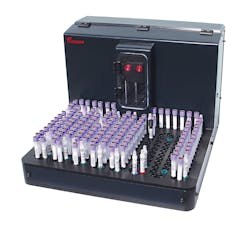The role of plasma viscosity testing in managing COVID-19 disease
Plasma viscosity levels are significantly increased in patients testing positive for SARS-CoV-2, and an inexpensive, accurate test aids in identifying positive cases and monitoring disease progression. The emergence of a novel pneumonia-inducing condition was reported in Wuhan, China, in late 2019, resulting in an unprecedented global pandemic, infecting at least 140 million people and responsible for more than 3 million deaths worldwide.1 Originally designated 2019 novel coronavirus (2019-nCOV), the World Health Organization (WHO) formally named the disease COVID-19 with the causative virus responsible being termed severe acute respiratory syndrome coronavirus (SARS-CoV-2).2
Symptoms range from cough, pyrexia and loss of taste/smell, to severe respiratory disorders, cytokine storm, microclot formation and multi-organ failure. Reports reveal that 20% of positive cases are asymptomatic, 14% are severe and needing medical attention, and 5% require critical care. At present, there is no blood test for virus severity.
Traditional use of plasma viscosity
Prior to the emergence of COVID-19, plasma viscosity (PV) testing has been commonplace for many years, albeit in larger specialist referral laboratories.
Together with erythrocyte sedimentation rate (ESR) and C-reactive protein (CRP), PV provides a measure of acute-phase response; essentially an early inflammatory response that is associated with an increase in plasma proteins and fibrinogen. These fundamentally provide an indirect measure of infection, inflammation and malignancy.
Plasma viscosity testing is useful in diagnosing and monitoring conditions, including temporal arteritis and polymyalgia rheumatica. In particular, it is essential to monitor PV levels regularly in cases of Waldenström macroglobulinaemia, which is attributed to an elevated production of paraproteins and can escalate to what is known as ‘hyperviscosity syndrome.’ This syndrome presents with neurological abnormalities, visual aberration, and mucosal bleeding. Myocardial infarction can occur if left untreated.
Hyperviscosity causes damage to the endothelium and is a known contributing risk factor for thrombosis. Determining PV levels in these patients allows for monitoring of disease progression and/or treatment success, making it vital.
Plasma viscosity versus ESR
Plasma viscosity testing has many advantages over the traditional ESR (erythrocyte sedimentation rate). Unlike ESR, PV is unaffected by anemia and polycythemia, can differentiate between protein abnormalities and inflammatory processes, and is less susceptible to pre-analytical and physiological variables. Plasma viscosity is also more stable and can be measured up to seven days after venipuncture, compared to ESR, which ideally needs to be analyzed within four hours at room temperature, or 24 hours at 4˚C. This can make a huge difference for rural locations or in less-developed countries where transportation links may not be as well established. The majority of modern clinical viscometers are semi/fully automated methods, with testing taking as little as 10 minutes when the centrifugation step is taken into account. In the traditional Westergren method, analysis can take over an hour inclusive of sufficient mixing prior to analysis.
Plasma viscosity analysis also has the advantage of a uniform reference range for both sexes (1.5–1.72 mPas). Most modern viscometers perform a serum viscosity with no additional changes to the system or reagents. This can be beneficial if clinicians want to exclude the effects of fibrinogen from the result. Some also have the potential to perform a whole blood viscosity.
Plasma viscosity in critically ill patients with COVID-19
Very few publications have described the correlation between COVID-19 and its effect on the viscosity of the patient’s plasma. A recent study conducted by Maier et al.3 showed that in a small cohort of 15 critically ill COVID-19 patients admitted to an intensive treatment unit, all displayed a significantly raised PV level of 1.9–4.2 mPas (reference range 1.5–1.72 mPas).
It was also shown that there was a strong correlation between the viscosity of the patient’s plasma and their sequential organ failure assessment score (P<0.001), which provides a prediction of mortality based on the severity of organ dysfunction.3
A second study conducted by Truong et al.4 looked at the use of therapeutic plasma exchange in six patients critically ill with COVID-19. The pre-treatment PV levels in their selected patients were 2.6–4.2 mPas, with a median of 3.75 mPas.4 Both of these studies show the relationship between severity of COVID- 19 and the significantly raised viscosity of the patient plasma.
Diagnostic value of PV testing for patients with COVID-19
Two of the major limitations of the previous studies were cohort size and restricting the PV measurements to only critically ill COVID-19 patients. To address these limitations, we wanted to measure the PV of all hospitalized COVID-19 patients who displayed a broad range of symptoms. The set-up was simple: measure the PV of all patients presenting to hospital with COVID-19 symptoms, then separate patients into a positive and negative group, once the polymerase chain reaction (PCR) results of their upper respiratory swabs were known. We did not want to measure the positive group against a ‘normal,’ healthy population.
Essentially, the question was: Could the PV alone differentiate between two unhealthy patient cohorts?
We analyzed these patients. Those patients testing positive for COVID-19 had a mean PV of 2.00 mPas, compared to the negative group having a mean PV of 1.62 mPas, which was statistically significant (P<0.0001).5 We were also able to determine a cut-off PV of 1.83 mPas, which has a sensitivity of 69.6% and specificity of 98.7% for COVID-19.5 Using plasma viscosity5 alone, we can clearly distinguish between these two patient cohorts with relative accuracy.
Future research
There are many possible avenues for future research. Performing serum viscosity testing would eliminate the interference of fibrinogen and hopefully, provide a more sensitive method of measuring the paraprotein level in these patients. This may have the potential to measure the level of antibody titers, and act as an indirect measure of patient immune response. If so, can we predict if a patient is recovering favorably, or is disease progression worsening?
A multi-center study would enable us to understand any geographical variations, not just in respect of the ethnicity of the patient population, but also in the effect potential SARS-CoV-2 variants have on plasma viscosity levels. For example, we could address the question: Do different variants affect the viscosity of plasma in the same way, and to what extent?
It would also be beneficial to determine the PV levels of COVID-19 patients in their respective categorized symptomatic groups (i.e., mild, moderate, and severe) and, if possible, also the asymptomatic cases. Determining a PV cutoff or reference range for each group could provide clinicians with addition information as to whether the patient condition is improving or deteriorating.
Conclusion
Plasma viscosity has a role to play in the diagnostic triage of suspected COVID-19 patients, as increased serum proteins contribute to the reported hyperinflammatory and prothrombotic states. This test has the potential to be incorporated into a patient’s pre-admission diagnostic workup with little additional burden to labs. For those critically ill, routinely measuring the plasma viscosity may provide additional evidence to the clinical teams on the direction the disease is taking. This may provide supplementary evidence that prompts earlier intervention or cessation of certain treatment.
References
- Coronavirus Resource Center. Johns Hopkins University. https://coronavirus.jhu.edu/. Accessed April 27, 2021.
- Cascella M, Rajnik M, Cuomo A, Dulebohn SC, Napoli RD. Features, Evaluation, and Treatment of Coronavirus (COVID-19). Treasure Island (FL): StatPearls Publishing; 2021. [Internet]. http://www.ncbi.nlm.nih.gov/books/NBK554776. Accessed April 27, 2021.
- Maier CL, Truong AD, Auld SC, Polly DM, Tanksley CL, Duncan A. COVID-19- associated hyperviscosity: a link between inflammation and thrombophilia? Lancet. 2020; 395 (10239): 1758–9. doi: 10.1016/S0140-6736(20)31209-5.
- Truong AD, Auld SC, Barker NA et al. Therapeutic plasma exchange for COVID-19-associated hyperviscosity. Transfusion. 2021; 61 (4):1029–34. doi: 10.1111/trf.16218.
- Gleghorn DM, Orisadare O, Omer A, Lynn R, Norcliffe D, Robinson M. Diagnostic value of plasma viscosity testing for patients with COVID-19. Int J Lab Hematol. 2021 Apr 4. doi: 10.1111/ijlh.13532.
About the Author

Daniel Gleghorn
is a Senior Biomedical Scientist in the Automated Diagnostic Haematology Laboratory, Department of Clinical Haematology at Addenbrooke’s Hospital, Cambridge, UK.
